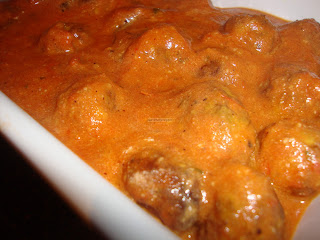Low Fat Dum Aloo
During one of my routine weekly shoppings I noticed that we get what are called miniature baby potatoes. These are the size of the baby potatoes we used to get in India. Strangely, the ‘baby potatoes’ we used to get normally was the size of an average potato in India. I used to wonder if baby here meant toddler. Anyway, now that I get the real small potatoes, first thing I thought I should do was Dum Aloo. I also had a book by Tarla Dalal that had the recipe for this awesome dish. The moment I saw deep fry in it I was a bit disappointed. I then wanted to adapt that recipe to reduce fat and as always baking came in handy. So, that’s the story about the origin of this recipe in my kitchen. I really loved the outcome and I had made it so hot, I loved it. I have reduced the number of chillies in this recipe to reduce heat, increase or decrease further based on your preference. One mistake I did was I did not prick the potatoes before roasting them. I would do it the next time or else they seem a bit funny when you bite into them. Here is the adapted version...
For the potatoes:
15-20 baby potatoes
2 tablespoon oil
1 teaspoon chilly powder
1 teaspoon dhania powder (coriander powder)
1 teaspoon jeera powder (cumin powder)
1 teaspoon kasoori methi (dried fenugreek leaves)
Salt to taste
Turmeric powder
For gravy:
2 cups chopped tomatoes
3 dry red chillies
4-5 cashew nuts (optional)
1 teaspoon cumin seeds
1 teaspoon chopped ginger
Pierce each potato using a fork and combine all ingredients mentioned for potatoes. Marinade for about 10-15 minutes. (just washing the potatoes is enough, the skin will help keep it crispy)
Bake the potatoes on foiled baking tray at 220degC for about 20-30 minutes and keep moving them every ten minutes. Once done, try to resist temptation to eat them straight away.
While potatoes are baking, combine all ingredients mentioned for gravy in a saucepan. Cook in 2 cups water until well done. Cool and blend until smooth and bring back to saucepan, add salt.
Add the potatoes simmer for about 10 minutes, add water if needed.
Serve with a nice Indian bread or pulav.

















































